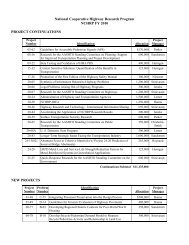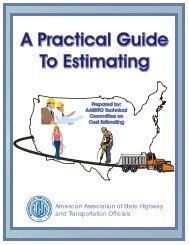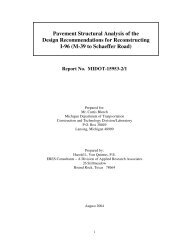Summary of AgileAssets findings on potential use of PMS for ...
Summary of AgileAssets findings on potential use of PMS for ...
Summary of AgileAssets findings on potential use of PMS for ...
You also want an ePaper? Increase the reach of your titles
YUMPU automatically turns print PDFs into web optimized ePapers that Google loves.
Finally, the <str<strong>on</strong>g>findings</str<strong>on</strong>g> in this project are that every state can begin to <strong>use</strong> their pavement<br />
management system to calibrate new MEPDG. However, this will not be a short-term<br />
ef<strong>for</strong>t and is not intended to replace the a<strong>for</strong>ementi<strong>on</strong>ed short-term calibrati<strong>on</strong>/validati<strong>on</strong><br />
activity. It will supplement that ef<strong>for</strong>t but in the l<strong>on</strong>g run will be more valuable to the<br />
state than the intensive early ef<strong>for</strong>t.<br />
Key to this <strong>PMS</strong> ef<strong>for</strong>t will be the establishment <str<strong>on</strong>g>of</str<strong>on</strong>g> a Satellite <strong>PMS</strong>/Pavement Design<br />
Database which will c<strong>on</strong>tain not <strong>on</strong>ly the pavement management data but the design<br />
data and follow up as-built and actual data <strong>for</strong> each individual pavement secti<strong>on</strong><br />
designed and c<strong>on</strong>structed based <strong>on</strong> results <str<strong>on</strong>g>of</str<strong>on</strong>g> the MEPDG. This intensive data, listed in<br />
the various Matrix columns, will not be required <strong>for</strong> the entire pavement management<br />
system, <strong>on</strong>ly <strong>for</strong> those secti<strong>on</strong>s built based <strong>on</strong> the design from the MEPDG.<br />
What are the next steps in the process <str<strong>on</strong>g>of</str<strong>on</strong>g> realizing the benefits <str<strong>on</strong>g>of</str<strong>on</strong>g> using pavement<br />
management data in calibrating the new MEPDG? The first step would be to<br />
dem<strong>on</strong>strate the <strong>potential</strong> by working closely with two states, <strong>potential</strong>ly two states <str<strong>on</strong>g>of</str<strong>on</strong>g><br />
the eight already visited. With minimum funding, a team <str<strong>on</strong>g>of</str<strong>on</strong>g> experts knowledgeable in<br />
this area can work with the states to set up the Satellite <strong>PMS</strong>/PD Database and<br />
illustrate the benefits <str<strong>on</strong>g>of</str<strong>on</strong>g> taking as-built and other required data and putting it into that<br />
satellite database <strong>for</strong> future analysis.<br />
At the same time, it would be ideal to broaden the educati<strong>on</strong> aspects <str<strong>on</strong>g>of</str<strong>on</strong>g> the process by<br />
c<strong>on</strong>ducting four regi<strong>on</strong>al workshops across the United States involving all 50 state<br />
DOTs and preferably as many as three pers<strong>on</strong>s from each DOT in order that a team<br />
spirit can be built at the workshop. These workshops would provide hands-<strong>on</strong> break-out<br />
sessi<strong>on</strong>s where the staff and possibly members DGIT team can participate in sharing<br />
ideas <strong>on</strong> how to move <strong>for</strong>ward.<br />
Thirdly, it is important that FHWA encourage multi-state ef<strong>for</strong>ts at pavement<br />
management calibrati<strong>on</strong> <str<strong>on</strong>g>of</str<strong>on</strong>g> the Guide. If data from five or more states is collated into a<br />
comm<strong>on</strong> database with similar data elements, the number <str<strong>on</strong>g>of</str<strong>on</strong>g> secti<strong>on</strong>s available <strong>for</strong><br />
calibrati<strong>on</strong> can be increased from 5 – 10 to 30 – 50 or more. It is important that state<br />
DOTs begin the process <str<strong>on</strong>g>of</str<strong>on</strong>g> testing their pavement management data <strong>for</strong> <strong>use</strong> and<br />
calibrati<strong>on</strong>. This requires the applicati<strong>on</strong> <str<strong>on</strong>g>of</str<strong>on</strong>g> statistical-analytical capability to the data<br />
collected in the Satellite <strong>PMS</strong>/PD database.<br />
If this type <str<strong>on</strong>g>of</str<strong>on</strong>g> integrati<strong>on</strong> can be fomented then perhaps c<strong>on</strong>tinuity <str<strong>on</strong>g>of</str<strong>on</strong>g> pavement design<br />
guides can be established. Too <str<strong>on</strong>g>of</str<strong>on</strong>g>ten in the past, a new pavement design guide has<br />
been initiated (there have been four major modificati<strong>on</strong>s to the guide since 1962). Each<br />
time that Guide is c<strong>on</strong>sidered to be the final versi<strong>on</strong>, but after five to ten years it<br />
becomes clear that the results are not adequate <strong>for</strong> accurate pavement design<br />
nati<strong>on</strong>wide and a totally new ef<strong>for</strong>t at design guide development begins, as in this case<br />
in 1995 when work <strong>for</strong> the current MEPDG was started. If c<strong>on</strong>tinuity can be<br />
reestablished between pavement management and pavement design and if a l<strong>on</strong>g-term<br />
database can be established, then gradual improvements can be made building toward<br />
a comm<strong>on</strong> goal <strong>for</strong> solid mechanistic empirical pavement per<strong>for</strong>mance predicti<strong>on</strong>s and<br />
design.<br />
1/8/08 <str<strong>on</strong>g>Summary</str<strong>on</strong>g> 5
















